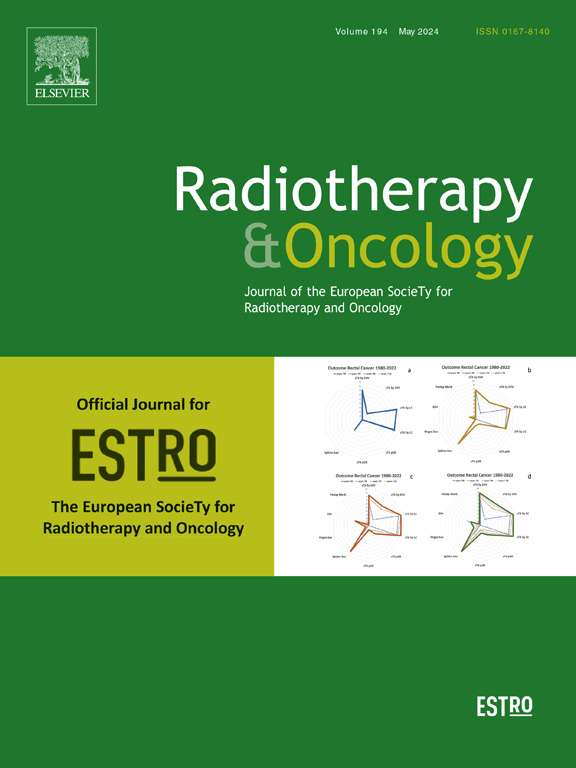Transforming the management of radiotherapy-induced hypothyroidism in nasopharyngeal carcinoma through an Innovative individualized radiation dosage model: A multicenter retrospective analysis
IF 4.9
1区 医学
Q1 ONCOLOGY
引用次数: 0
Abstract
Purpose
Current guidelines for thyroid radiation dose prescription lack uniformity and fail to consider the unique characteristics of individual patients. This study aimed to develop an individualized thyroid dosing regimen to enhance thyroid protection during radiotherapy.
Methods and Materials
In this study, we enrolled 621 patients with nasopharyngeal carcinoma (NPC) across four distinct cancer centers, stratifying the data into a training cohort and two external validation cohorts. The specific clinical characteristic-matched tolerated dose values were fitted using binary logistic regression and time-to-event Cox methods in the training cohort. The TSH-volume index (TVI), calculated as thyroid-stimulating hormone (TSH) level divided by thyroid volume (TV), was introduced as a novel parameter. A radiation-induced hypothyroidism (RIHT) parameter was developed using the volume of thyroid spared at the tolerated dose (VStd) and compared with classical normal tissue complication probability (NTCP) and machine learning models using the area under the curve (AUC) and concordance index (C-index).
Results
The follow-up periods spanned 28 (range, 1–66), 33.5 (range, 3–82), and 17 months (range, 2–56), respectively, across these cohorts. RIHT was observed in 27.7 % and 35.3 % of patients at 2 and 3 years in the training cohort, respectively; 30.0 % and 41.5 % in the external validation cohort 1; and 27.2 % and 38.0 % in the external validation cohort 2. Univariable analysis identifies sex, equivalent uniform dose (EUD), TV, TSH, and the TVI as predictors of RIHT, while multivariable analysis confirms EUD and TVI as independent prognostic factors. The TVI-based VStd parameter outperformed the VS40, VS45, and VS50 indices (representing volumes spared at 40 Gy, 45 Gy, and 50 Gy, respectively), classical NTCP models, and even machine learning models in predictive performance. To enhance clinical applicability, we have developed a thyroid dose prescription table based on TVI.
Conclusions
We developed a high-accuracy model for individualized thyroid dosing in NPC radiotherapy. The model, supported by a clinically relevant table, offers a customized approach to thyroid protection, enhancing both predictive accuracy and clinical utility.
创新个体化放疗剂量模型改变鼻咽癌放疗性甲状腺功能减退的治疗:一项多中心回顾性分析
目的:现行甲状腺放射剂量处方指南缺乏统一性,未能考虑个体患者的独特特征。本研究旨在制定个体化甲状腺给药方案,以增强放疗期间甲状腺保护。方法和材料:在这项研究中,我们从四个不同的癌症中心招募了621例鼻咽癌(NPC)患者,将数据分为培训队列和两个外部验证队列。在训练队列中,使用二元logistic回归和时间-事件Cox方法拟合特定临床特征匹配的耐受剂量值。引入促甲状腺激素(TSH)水平除以甲状腺体积(TV)的TSH体积指数(TVI)作为新参数。使用耐受剂量下的甲状腺体积(VStd)建立辐射性甲状腺功能减退(right)参数,并使用曲线下面积(AUC)和一致性指数(C-index)与经典的正常组织并发症概率(NTCP)和机器学习模型进行比较。结果:在这些队列中,随访期分别为28个月(范围1-66)、33.5个月(范围3-82)和17个 个月(范围2-56)。在训练队列中,2年和3 年时,分别有27.7% %和35.3% %的患者出现right;外部验证队列1为30.0 %和41.5 %;在外部验证队列2中为27.2% %和38.0% %。单变量分析发现性别、等效均匀剂量(EUD)、TV、TSH和TVI是right的预测因子,而多变量分析证实EUD和TVI是独立的预后因素。基于tv的VStd参数在预测性能上优于VS40、VS45和VS50指数(分别代表40 Gy、45 Gy和50 Gy的体积)、经典NTCP模型,甚至机器学习模型。为提高临床适用性,我们开发了基于TVI的甲状腺剂量处方表。结论:我们建立了一个高精度的鼻咽癌放疗个体化甲状腺剂量模型。该模型由临床相关表支持,提供了定制的甲状腺保护方法,提高了预测准确性和临床实用性。
本文章由计算机程序翻译,如有差异,请以英文原文为准。
求助全文
约1分钟内获得全文
求助全文
来源期刊

Radiotherapy and Oncology
医学-核医学
CiteScore
10.30
自引率
10.50%
发文量
2445
审稿时长
45 days
期刊介绍:
Radiotherapy and Oncology publishes papers describing original research as well as review articles. It covers areas of interest relating to radiation oncology. This includes: clinical radiotherapy, combined modality treatment, translational studies, epidemiological outcomes, imaging, dosimetry, and radiation therapy planning, experimental work in radiobiology, chemobiology, hyperthermia and tumour biology, as well as data science in radiation oncology and physics aspects relevant to oncology.Papers on more general aspects of interest to the radiation oncologist including chemotherapy, surgery and immunology are also published.
 求助内容:
求助内容: 应助结果提醒方式:
应助结果提醒方式:


